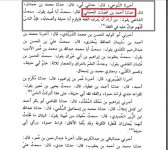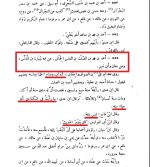I am sorry.
I don't play 'go read the link'. Anything you want to present, present it in your own words/write it out yourself or even copy it if you want. Unless it is a scan (for obvious reasons.)
Second you quoted my post and replied to something which was not even mentioned in this post.
Third, I have told you to prove the prayer of Hanafi women using
1) Weak ahadeeth, I challenged you that even using weak ahadeeth you cannot
2) Then I said using the sayings of Abu Haneefah.
You haven't done any of that until now.
The Shafi‘i Madhhab
Imam al-Nawawi (631 – 676 H), the great Shafi‘i muhaqqiq, said:
قال الشافعي رحمه الله فى المختصر: ولا فرق بين الرجال والنساء في عمل الصلاة، إلا أن المرأة يستحب لها أن تضم بعضها إلى بعض وأن تلصق بطنها بفخذيها فى السجود كأستر ما يكون، وأحب ذلك فى الركوع وفي جميع الصلاة، وأن تكثف جلبابها وتجافيه راكعة وساجدة لئلا يصفها ثيابها، وأن تخفض صوتها وإن نابها شيء في صلاتها صفقت، هذا نصه.
قال أصحابنا: المرأة كالرجل في أركان الصلاة وشروطها وأبعاضها وأما الهيئات المسنونات فهي كالرجل في معظمها وتخالفه فيما ذكره الشافعي، وىخالف النساء الرجال في صلاة الجماعة في أشياء…
“Al-Shafi‘i – may Allah have mercy on him – said in al-Mukhtasar: ‘There is no distinction between men and women in the actions of Salah, except that it is preferable for the woman that part of her clings to a part, and her stomach clings to her thighs in prostration in a manner that is most concealing (for her), and I prefer this in bowing and in the entire Salah; and that she makes her jilbab thick and she separates it (from her body) while bowing and prostrating so that her clothing does not describe her (i.e. her shape and form); and that she lowers her voice and if something occurs to her in her Salah (while in congregation), she claps (i.e. to alert the imam to the mistake).’ This is his (i.e. al-Shafi‘i’s) statement.
“Our companions said: The woman is like the man in the integrals of Salah, its conditions and its parts. As for the prescribed postures, she is like the man in most of them and she differs from him in what al-Shafi‘i mentioned. And women differ from men in congregational prayer in some things…” (al-Majmu‘ Sharh al-Muhadhdhab, 3:495)
The Hanbali Madhhab
Muwaffaq al-Din Ibn Qudamah al-Maqdisi (541 – 620 H), the great Hanbali muhaqqiq, said:
مسألة: قال: والرجل والمرأة في ذلك سواء إلا أن المرأة تجمع نفسها فى الركوع والسجود وتجلس متربعة أو تسدل رجليها فتجعلهما في جانب يمينها.
الأصل أن يثبت في حق المرأة من أحكام الصلاة ما يثبت للرجال لأن الخطاب يشملهما، غير أنها خالفته في ترك التجافي لأنها عورة فاستحب لها جمع نفسها ليكون أستر لها، فإنه لا يؤمن أن يبدو منها شيء حال التجافي. وكذلك فى الافتراش.
قال أحمد: والسدل أعجب إلي. واختاره الخلال. قال علي رضي الله عنه: إذا صلت المرأة فلتحتفز ولتضم فخذيها وعن ابن عمر رضي الله عنهما أنه كان يأمر النساء أن يتربعن فى الصلاة
“Ruling: He (i.e. Abu l-Qasim al-Khiraqi al-Hanbali, (d. 334 H)) said: ‘And the man and woman are equal in this (i.e. the description of Salah) except that the woman collects herself when bowing and prostrating and she sits in the tarabbu‘ position (inserting the left foot between the thigh and shin of the right leg) or she practises sadl by placing them both to her right side.’
“The default is that whatever is established for men from the rules of Salah is established with respect to a woman because the address (of the Shari‘ah) encompasses both of them; except that she differs from him in not separating (her limbs) because she is ‘awrah (as established in hadith). Hence, it is preferred for her to collect herself so that it is more concealing for her, because there is no surety that something will not appear from her in the situation of separating (her limbs), and likewise when (sitting in) the iftirash position (i.e. erecting the right foot so the toes point towards the qiblah and sitting on the left foot).
“Ahmad said: ‘Sadl is more appealing to me.’ Al-Khallal preferred this. ‘Ali (may Allah be pleased with him) said: ‘When the woman prays, she should draw (herself) together, and join her thighs,” and (it was narrated) from Ibn ‘Umar (may Allah be pleased with him) that he would order the women to adopt the tarabbu‘ position in Salah.” (Mughni, Dar ‘Alam al-Kutub, 2:258-9)
Imam Ahmad’s son, ‘Abd Allah, narrates:
قلت: كيف تسجد المرأة وكيف تقعد للتشهد؟ قال: كيف كان أستر
“I said (to Imam Ahmad): ‘How does a woman prostrate and how does she sit for Tashahhud?’ He said: ‘However is most concealing (for her).’” (Masa’il al-Imam Ahmad ibn Hanbal Riwayat Ibnihi ‘Abdillah ibn Ahmad, al-Maktab al-Islami, p. 79)
The Maliki Madhhab
Ibn Abi Zayd al-Qayrawani (d. 386) – known as “little Malik” – stated in his treatise on Maliki fiqh:
وهي في هيئة الصلاة مثله غير أنها تنضم ولا تفرج فخذيها ولا عضديها في جلوسها وسجودها وأمرها كله
“And she (i.e. the woman) in the posture(s) of Salah is like him (i.e. the man), except that she draws (herself) together and she does not part her thighs, nor her upper arms during her sitting, her prostration and her entire affair.”
‘Ali ibn Khalaf al-Manufi al-Maliki’s (857 – 939 H) comments on this passage:
وما ذكره رواية ابن زياد عن مالك وهو خلاف قول ابن القاسم فى المدونة لأنه ساوى بين الرجل والمرأة فى الهيئة
“What he (i.e. Ibn Abi Zayd) stated is the narration of Ibn Ziyad from Malik and it is contrary to the narration of Ibn al-Qasim in al-Mudawwanah because he equated between the man and woman in the posture(s).”
And al-‘Adawi (d. 1189 H) said in his marginalia to this work:
الراجح كلام المصنف الذي هو رواية ابن زياد، ورواية ابن القاسم ضعيف كما هو المفهوم من خليل وشراحه
“The preferred (view) is the opinion of the author (Ibn Abi Zayd) which is the narration of Ibn Ziyad (from Malik); and the narration of Ibn al-Qasim is weak as is understood from (the Mukhtasar of) Khalil and its commentators.”
(Kifayat al-Talib al-Rabbani, Matba‘ah al-Madani, 1:551-2)
In summary, there are two views in the Maliki madhhab both narrated from Imam Malik. One, that a woman is exactly the same as a man in the postures of Salah. And the second that a woman differs from him in that she draws herself together and does not separate her limbs in all the postures of Salah. The favoured view of the madhhab is the latter, making it equivalent to the other madhhabs.
Hence, all of the four madhhabs agree that a woman differs from a man in the postures of salah, in that she adopts the positions that are most concealing for.


